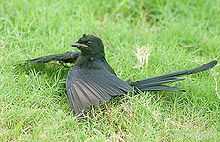Anting (bird activity)

Anting is a self-anointing behavior during which birds rub insects, usually ants, on their feathers and skin. The bird may pick up the insects in their bill and rub them on the body, or the bird may lie in an area of high density of the insects and perform dust bathing-like movements. The insects secrete liquids containing chemicals such as formic acid, which can act as an insecticide, miticide, fungicide, or bactericide. Alternatively, anting could make the insects edible by removing the distasteful acid, or, possibly supplement the bird's own preen oil. Instead of ants, birds can also use millipedes. Over 250 species of bird have been known to ant.
Function
It has been suggested that anting is way of reducing feather-parasites such as mites, or controlling fungi or bacteria, although there has been little convincing support for any of those theories.[1][2] It is possible that the use of certain kinds of ants indicates the importance of the chemicals they release. Some cases of anting involved the use of millipedes or puss moth (Cerura vinula) caterpillars,[3] and these, too, are known to release powerful defensive chemicals.[4]
Another suggestion, based on observation of blue jays, is that the bird makes the insects edible by discharging the harmful acid onto its feathers. Birds were found to show anting behaviour only if the ants had a full acid sac, and with subjects whose acid sacs had been experimentally removed, the behaviour was absent.[5]
It has also been suggested that anting is related to moulting. Correlation with moulting, however, may be attributable to the greater activity of ants in summer.[6]
History
This behaviour was first described by Erwin Stresemann in German as Einemsen in the German ornithology journal Ornithologische Monatsberichte (Volume XLIII, p. 138) in 1935. Indian ornithologist Salim Ali interpreted an observation by his cousin Humayun Abdulali in the 1936 volume of Journal of the Bombay Natural History Society and included a reference to the Stresemann's paper suggesting that the German term could be translated into English as "anting".[7]
Related behaviours
Dusting with soil from ant-hills has been considered by some as equivalent to anting.[8]
Some birds like antbirds and flickers not only ant, but also consume the ants as an important part of their diet. Other opportunist ant-eating birds include sparrows, wrens, grouse and starlings.[9]
See also
References
- ↑ Revis, H.C. and Waller, D.A. (2004). "Bactericidal and Fungicidal Activity of ant chemicals on feather parasites: an evaluation of anting behavior as a Method of Self-medication in Songbirds". The Auk 121 (4): 1262–1268. doi:10.1642/0004-8038(2004)121[1262:BAFAOA]2.0.CO;2. JSTOR 4090493.
- ↑ Lunt, N, P.E.Hulley, A. J. F. K. Craig (2004). "Active anting in captive Cape White-eyes Zosterops pallidus". Ibis 146 (2): 360–362. doi:10.1111/j.1474-919X.2004.00264.x.
- ↑ Tinbergen, Niko (1974). Curious Naturalists. University of Massachusetts Press. p. 107.
- ↑ Clunie, F. (1976). "Jungle mynah "anting" with millipede". Notornis 23: 77.
- ↑ Eisner, T.; Aneshansley, D (2008). ""Anting" in Blue Jays, evidence in support of a food-preparatory function". Chemoecology 18 (4): 197–203. doi:10.1007/s00049-008-0406-3. PMC 2630239. PMID 19169379.
- ↑ Power, E. E and D. C. Hauser (1974). "Relationship of Anting and Sunbathing to Molting in Wild Birds". The Auk 91 (3): 537–563. doi:10.2307/4084474.
- ↑ Ali, Salim (1936). "Do birds employ ants to rid themselves of ectoparasites?". Journ. Bombay Nat. Hist. Soc. 38 (3): 628–631.
- ↑ Kelso, L. and Nice, Margaret M. (1963). "A Russian contribution to anting and feather mites". The Wilson Bulletin 75 (1): 23–26.
- ↑ Taber, Stephen Welton (1998). The World of the Harvester Ants. W.L. Moody, jr. Natural History Series 23. Texas A&M University Press.